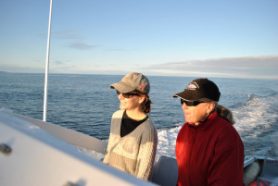Delilah’s legacy
Scientist reroutes shipping lanes in the Bay of Fundy
Share this:
- Share via email (Opens in new window) Email
- Click to share on Facebook (Opens in new window) Facebook
- Click to share on X (Opens in new window) X
- Click to share on Pinterest (Opens in new window) Pinterest
- Click to share on Reddit (Opens in new window) Reddit
- Share to Google Classroom (Opens in new window) Google Classroom
- Click to print (Opens in new window) Print
By Eric Wagner

Brown suspected that ships and whales just spent too much time in the same waters, due to the placement of the shipping lanes. Shipping lanes are like highways on the ocean that large ships have to follow. They are set by the International Maritime Organization, which won’t change them without good reason.
For the shipping lanes to be moved, Brown had to be sure that her hypothesis was correct. She took years of right whale sightings to Chris Taggart and Angelia Vanderlaan, two scientists at Dalhousie University in Halifax, Nova Scotia. Vanderlaan and Taggart compared where shipping lanes were against the sites where right whales were especially active. This showed those lanes crossed through areas where whales most liked to dine on plankton.
In 1998, Brown and her coworkers presented their findings to Irving Oil, the largest company whose ships moved through the Bay of Fundy. “We knew the whales,” Brown says, and Irving Oil “knew the ships.” The biologists said that one way to fix the problem would be to move the shipping lanes a little bit. The shipping company agreed. Together with other groups, the scientists and Irving Oil proposed such a change to the Canadian transportation agency, which passed it along to the International Maritime Organization.
It took time for the organization to consider all of the information. Reports had to be submitted. Brown remained patient. That proved hard at times, because every year that nothing changed, right whales continued to face grave danger. Sometimes, she wondered if the lanes would ever get moved.
But in 2003, the shipping lanes were rerouted around the area with the highest concentration of right whales. Almost at once, biologists saw a benefit: The chance that a ship would collide with a whale dropped by 90 percent. Since then, no whales have died from ship strikes in the Bay of Fundy.







